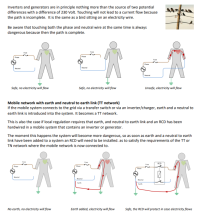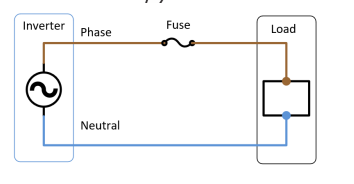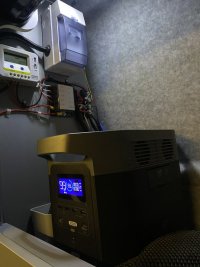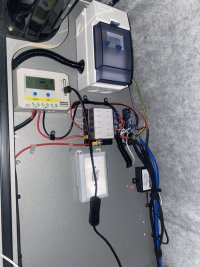Is it possible to connect a power station battery in some way giving me use of the internal 3 pin plugs that only work when connected to mains from the outside connection. Bypassing or connecting a 3pin plug from the outside 3 phase and have one inside too to connect it to. I can then leave the eco flow delta hidden away in the side cabinet. Daft question or one that’s worth a thought!!
You are using an out of date browser. It may not display this or other websites correctly.
You should upgrade or use an alternative browser.
You should upgrade or use an alternative browser.
Electrical Question
- Thread starter Bazaboy66
- Start date
-
- Tags
- power-bank
I think this would be unit specific, i think the majority of them cant charge and output at the same time only one or the other, you would prob need to test or check the literature to be sure
@Dellmassive has one of these i think so he will probably know (and he if he doesnt im guessing he will very soon )
)
@Dellmassive has one of these i think so he will probably know (and he if he doesnt im guessing he will very soon
i have the Ecoflow River Pro . . - https://amzn.to/3reR91h


 uk.ecoflow.com
uk.ecoflow.com
its has a built in UPS feature . . .
where by you conect it to the mains . . . . then use its 240v output.

so . . . . you can just connect your EHU to it externally.
then run your sockets off this unit . . (upto the max power, 600w in this case)
.....................


EcoFlow RIVER 2 Pro Portable Power Station - EcoFlow UK
•Sizeable 768Wh capacity and 800W output. •Provides up to 1.8kWh a day from solar charging. •Fastest recharge 0-100% in only 70 min. •Safest LFP battery provides 10 years of use. •First power station with a TÜV Rheinland safety certification. •X-Boost output to 1600W and runs 80% of high-wattage...
its has a built in UPS feature . . .
where by you conect it to the mains . . . . then use its 240v output.

so . . . . you can just connect your EHU to it externally.
then run your sockets off this unit . . (upto the max power, 600w in this case)
.....................
or just have TWO socket outlets . .
one for EHU,
then one for ECOFLOW.
one for EHU,
then one for ECOFLOW.
I have this unit Dell.i have the Ecoflow River Pro . . - https://amzn.to/3reR91h
View attachment 144287

EcoFlow RIVER 2 Pro Portable Power Station - EcoFlow UK
•Sizeable 768Wh capacity and 800W output. •Provides up to 1.8kWh a day from solar charging. •Fastest recharge 0-100% in only 70 min. •Safest LFP battery provides 10 years of use. •First power station with a TÜV Rheinland safety certification. •X-Boost output to 1600W and runs 80% of high-wattage...uk.ecoflow.com
its has a built in UPS feature . . .
where by you conect it to the mains . . . . then use its 240v output.
View attachment 144288
so . . . . you can just connect your EHU to it externally.
then run your sockets off this unit . . (upto the max power, 600w in this case)
.....................

or . . .
you can use an Automatic mains transfer switch . . (Travelvolts used to sell them)
or a manual change over switch.
you can use an Automatic mains transfer switch . . (Travelvolts used to sell them)
or a manual change over switch.
so yes. . . with a EF Delta.
just put it inline with your EHU (inside the van) . . .
it will run the mains output upto its rating - 1800W/3300w inverter...
and will charge from EHU when thats connected.
just put it inline with your EHU (inside the van) . . .
it will run the mains output upto its rating - 1800W/3300w inverter...
and will charge from EHU when thats connected.
You can't backfeed from it is... back to the grid.
It needs to be inline with the mains coming into the van... Then out to the vans sockets.
If that's what you mean?.
Can you post a few pics or maybe explain what you want to do incase I'm miss reading the above.
It needs to be inline with the mains coming into the van... Then out to the vans sockets.
If that's what you mean?.
Can you post a few pics or maybe explain what you want to do incase I'm miss reading the above.
To have it working as a UPS like above...
You would need to change the wiring in the van a bit...
You need to rewire the EHU so it's connected to a single socket in a cupboard....
Use this socket to plug in the Delta's charging cable.
Now you need to take a 3pin plug from the output of the Delta and wire it to the other sockets in the van.
That way with no EHU the Delta powers the vans sockets.
Then when on EHU the Delta will charge and also pass mains through to the sockets.
You would need to change the wiring in the van a bit...
You need to rewire the EHU so it's connected to a single socket in a cupboard....
Use this socket to plug in the Delta's charging cable.
Now you need to take a 3pin plug from the output of the Delta and wire it to the other sockets in the van.
That way with no EHU the Delta powers the vans sockets.
Then when on EHU the Delta will charge and also pass mains through to the sockets.
That's a good idea......I would suggest wiring the van's battery charger into the EHU side of the socket and fuse it separately.
This will prevent you from accidentally discharging the delta into your vans leisure batteries!
Assuming he has a mains powered charger.
looks good . .
+++
So i suppose you can do like as mentioned above.
rewire the external EHU point to a separate socket next to the Delta. ( fit a double socket and move your EHU 7-stage charger over to the feed as well as @Samro suggested)
then use that socket to charge the delta via its charge lead.
Then make up a new lead that will go from the Delta mains output back up to main sockets in the van.
+++
Things to consider . . .
im not to sure what side of the arrangement the Consumer unit should go due to the RCBO breakers. (im thinking the CU should be EHU side due to the earth reference - if the CU was after the Delta then the RCBOs wouldn't work on an earth fault as the Delta is earth isolated?)
EHU is normally via 16A commando blue plug/socket thats 16A rated . . . But the Delta is 13A socket. so be sure not to exceed that. (though 1800w@240v is 7.5A) (3300w@240v is 13.8A)
basically dont pull too much power through the system . . . .
+++
+++
So i suppose you can do like as mentioned above.
rewire the external EHU point to a separate socket next to the Delta. ( fit a double socket and move your EHU 7-stage charger over to the feed as well as @Samro suggested)
then use that socket to charge the delta via its charge lead.
Then make up a new lead that will go from the Delta mains output back up to main sockets in the van.
+++
Things to consider . . .
im not to sure what side of the arrangement the Consumer unit should go due to the RCBO breakers. (im thinking the CU should be EHU side due to the earth reference - if the CU was after the Delta then the RCBOs wouldn't work on an earth fault as the Delta is earth isolated?)
EHU is normally via 16A commando blue plug/socket thats 16A rated . . . But the Delta is 13A socket. so be sure not to exceed that. (though 1800w@240v is 7.5A) (3300w@240v is 13.8A)
basically dont pull too much power through the system . . . .
+++
no problem  . . .
. . .
come join the VIP club for more greatness . . . - VIP Membership
like all this and more - Downloads
come join the VIP club for more greatness . . . - VIP Membership
like all this and more - Downloads
I would 100% be of the opinion that any breaker should live on the EHU side, due to the isolation of the Delta.im not to sure what side of the arrangement the Consumer unit should go due to the RCBO breakers. (im thinking the CU should be EHU side due to the earth reference - if the CU was after the Delta then the RCBOs wouldn't work on an earth fault as the Delta is earth isolated?)
However, it screws with my (puny) mind as to how the protection then works on the isolated system that would reside after the Delta. Bear in mind that on a campsite the bollard will have its own protection, so you will be well protected with EHU breaker (part if the campsite supply) with an additional breaker on the input side of your van.
So...... after the Delta...... earth leakage protection? How will that work? (Just interested!)
lol . . .I would 100% be of the opinion that any breaker should live on the EHU side, due to the isolation of the Delta.
However, it screws with my (puny) mind as to how the protection then works on the isolated system that would reside after the Delta. Bear in mind that on a campsite the bollard will have its own protection, so you will be well protected with EHU breaker (part if the campsite supply) with an additional breaker on the input side of your van.
So...... after the Delta...... earth leakage protection? How will that work? (Just interested!)
this is one of those mind bending questions that keeps me awake at night.
its also the same question about do i Bond my Inverter NEG to the chassis of the van . . ?
++++++++
according to Mr Victron . . . there is no chance of getting a Live/Earth sock from an isolated mains supply as there is no return path to the source.
so its the opinion that a floating Live/Netral double isolated feed is safe in the van with no earth connection.
+++
but an earth connection/bonding IS needed in the van is it is plugged into a EHU post as it will be earth referenced and there is a direct route back to the soursce.
+++
im not man enough to test the theory, nor am i a sparks - this is just what i have learned.
++++

+++
Inverter/charger is charger and feed through mode When the inverter is connected to AC power the AC input relay is closed and at the same time the earth relay is open. The AC output system relies on the AC power supply to provide the neutral to earth link. This link is needed so the RCD in the AC output circuit is operational.

+++
7.5 Mobile installations A mobile installation is an installation that operates independently from the grid. When it connects to AC power it usually connects to the grid at different locations and/or generators. For example, like boats, vehicles or mobile back-up power systems. In this chapter a boat installation is used, however, this information can be used for any mobile installation. A mobile system does not have an earth stake. So, something else in its place is needed to create a central earth potential. All touchable metal parts of the boat or vehicle must be connected to each other to create a local earth. Examples of metal parts in a boat or vehicle are: chassis, hull, metal fluid pipes, railing, engine, power point earth contacts, lightning conductors and the earth plate (if present). A mobile system typically connects to a variety of power sources it is sometimes not clear which of the leads in the shore power supply is connected to earth or if earth is connected at all. Also phase and neutral may have not been wired correctly. Connecting a supply like this to a mobile system can potentially create a short circuit to earth. Or earth is missing completely. It also matters if the mobile system connects to power or if it is disconnected from power and running autonomously
+++
Floating network in boat or vehicle (IT Network) In mobile system where an inverter (or generator) is the only power source one can specifically choose not to use a TT network but to use an IT network. In an IT network the phase and neutral are not coupled to another potential like earth. The voltages created by the independent power source are floating. A system like this is very safe and simple to install. If a conductor or housing in this system is touched by a person, no current can flow to earth. Remember, for current to flow a complete circuit is needed. In this system the earthing conductor is absent and the electric circuit to earth is not complete. This is a similar situation as the safety transformer in a bathroom.

...
Similar threads
- Replies
- 0
- Views
- 249
- Replies
- 9
- Views
- 2K
- Replies
- 8
- Views
- 1K
- Replies
- 1
- Views
- 728
- Replies
- 53
- Views
- 6K








